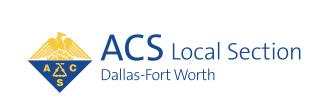
4 minute read
mRNA Vaccines
From the ACS Press Room Temperature Sensor could help Safeguard mRNA Vaccines
“Tamper-Proof Time-Temperature Indicator for Inspecting Ultracold Supply Chain” ACS Omega
Advertisement
.Scientists have developed vaccines for COVID-19 with record speed. The first two vaccines widely distributed in the U.S. are mRNA-based and require ultracold storage (-70 C for one and -20 C for the other). Now, researchers reporting in ACS Omega have developed a tamper-proof temperature indicator that can alert health care workers when a vial of vaccine reaches an unsafe temperature for a certain period, which could help ensure distribution of effective mRNA vaccines. The two COVID mRNA vaccines contain instructions for building harmless pieces of the SARS-CoV-2 spike protein. Once the vaccine is injected into the body, human cells use the mRNA instructions to make the spike protein, which they temporarily dis-
When the temperature of a glass vial containing simulated vaccine rises above -60 C for longer than 2 minutes, a blue dye in an adjacent tube diffuses into a white absorbent, leaving an irreversible color trace.
Credit: Adapted from ACS Omega 2021, DOI: 10.1021/acsomega.1c00404
play on their surface, triggering an immune response. But mRNA is highly unstable, requiring ultracold storage and transport conditions for the vaccines to remain effective. Sung Yeon Hwang, Dongyeop Oh, Jeyoung Park and colleagues wanted to develop a time-temperature indicator (TTI) to identify mRNA vaccines that are exposed to undesirable temperatures during storage or transport, so that they could be discarded. To make their TTI, the researchers added a mixture of ethylene glycol (antifreeze), water and blue dye to a small tube and froze it in liquid nitrogen. Then, they added a white cellulose absorbent to the top of the frozen coolant, turned the tube upside down, and adhered it to a larger glass vial containing simulated vaccine at -70 C. At temperatures above -60 C, the antifreeze mixture melted, and the dye diffused into the white absorbent, turning it light blue. The color change happened about 2 minutes after the simulated vaccine was exposed to a higher temperature. Importantly, exposures of less than 2 minutes –– which are unlikely to impair vaccine efficacy –– did not turn the TTI blue. The color change persisted if the tube was refrozen at -70 C, making the system tamper-proof. By changing the coolants or their mixing ratio, or by using different absorbents, the TTI could be tailored to monitor the ideal storage conditions of different mRNA vaccines, the researchers say. The authors acknowledge funding from the Korea Research Institute of Chemical Technology.

DFW ACS Photography Contest
The DFW local section of the ACS is organizing a photography contest during the “Chemists Celebrate Earth Week”. Please send ONE ORIGINAL picture to mihaela@utdallas.edu before April 23, 2021 for consideration in this science-art contest. Only one picture will be accepted per contestant. Different students from the same lab can individually submit. Both undergraduate and graduate students from schools in the DFW local section area (which includes schools from Dallas to Abilene) are eligible to participate. Please make sure you include your name, school, and what the submitted picture represents in the submission email.
The winning pictures will be posted on our ACS DFW webpage and on the Facebook page of the local section.
Submitted pictures can be of colorful reactions in the lab, images (AFM, TEM, SEM), cell images, fluorescent compounds.
We will select 3 pictures as winners. First prize will be $200, second prize $150, and 3rd prize $100.

The Chair’s Corner
Continued from page 6
standing chemistry student. The DFW Local Section is also very excited to be presenting the local Meeting in Miniature virtually on May 01, 2021. Additional information including abstract submission can be found on the webpage. Additionally, the Local Section is also looking at an industry-focused talk in May, and a graduatestudent led roundtable in May-June timeframe. April is also the time we celebrate our local section members who have reached the remarkable milestones of 50-, 60- and 70years of membership and service to the ACS. The local section members who have reached these milestones include: 50-Year Members: Dr. John Falck, Mrs. Bette McCue, Dr. Farida Saleh, and Dr. Linda Schultz 60-Year Members: Dr. Robert Adamski, Dr. Vinav Likhite, Mr. James Montgomery, and Dr. Scott Norton 70-Year Members: Mr. John Glover, Mr. Michael Jordan, and Dr. John Spessard We delightfully acknowledge these distinguished members who have contributed significantly to the ACS over many years. Congratulations. Once again, the executive committee is very excited about 2021 and the local section's future. If there is anything that I can do for you, please don’t hesitate to reach out at any time (trey.putnam@ttuhsc.edu). Best, Trey Putnam 2021 Chair DFW Local Section of the ACS








